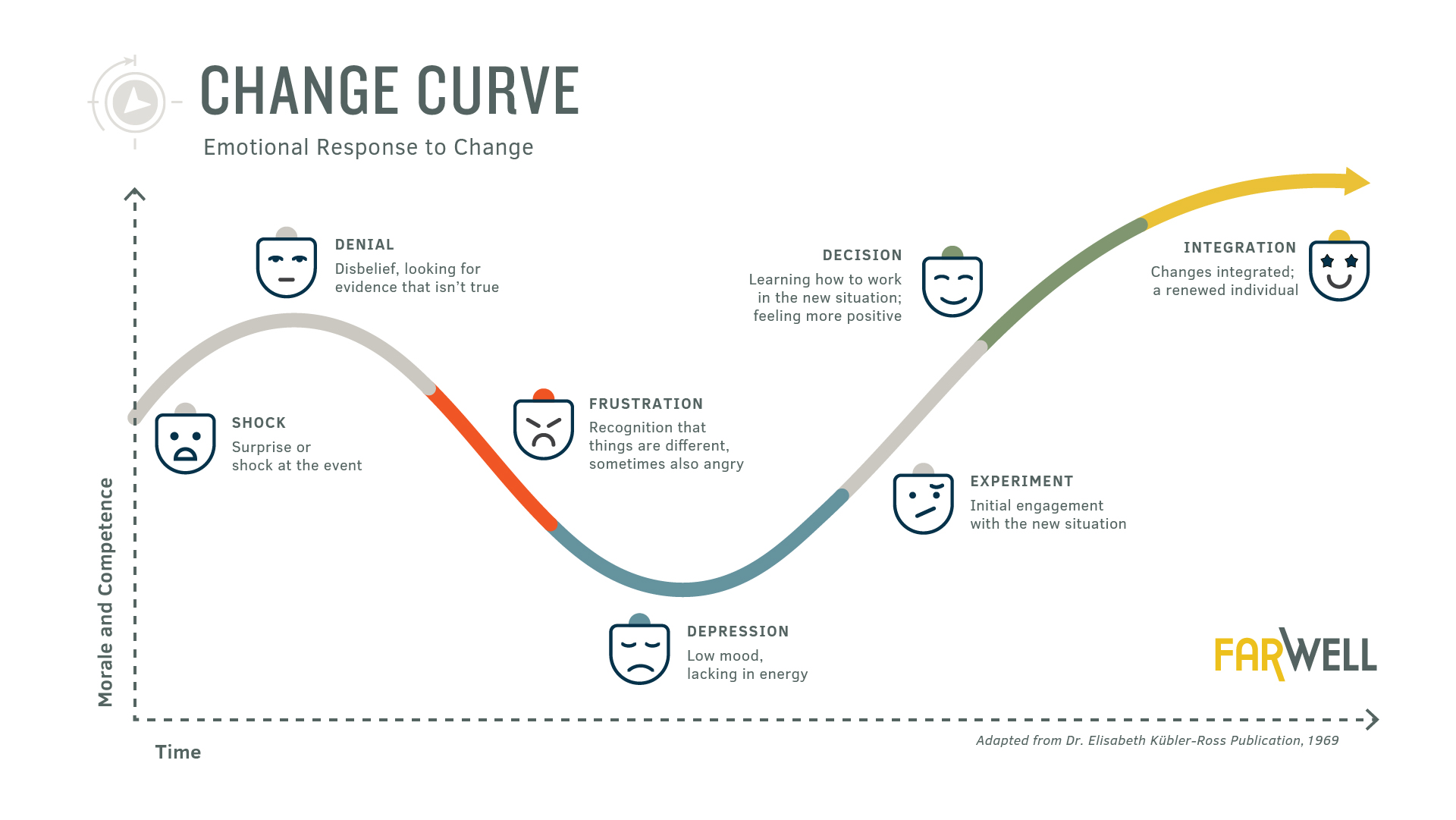Discover advisor articles and other FarWell resources.
Go far. Do well. Call (800) 987-2015
Change Management | 5 Essentials of Change Leadership

Culture is Critical | How to make work culture a part of leadership decisions.
October 25, 2018
Return on Investment | Process Optimization
November 20, 2018“Only one-quarter of employers are sustaining gains from change management initiatives.”
– Willis Towers Watson: Survey of Mid-size Organizations
Sustainable cultural or technological change is uniquely challenging for leadership in mid-size organizations. Rely on a change management team.
When leaders in an organization commit to change, they invest a substantial amount of resources into meeting their ambitious objectives. Yet, even after dedicating time, effort, and money to the initiative, far too many organizations fail to achieve the intended outcomes. And, those that do achieve their outcomes find it difficult to make any realized changes last.
Cultural, procedural and technological change require significant and specialized efforts. Willis Towers Watson: survey of Mid-sized Organizations revealed that 55 percent of leaders felt that their change initiatives met their initial objectives. However, only 25 percent said that they were able to sustain the gains from their initiatives over the long term. Leaders have contributed this failure to inadequate sponsorship, failure to prepare and support employees, and unrealistic expectations.
By employing proven change management techniques throughout a change initiative, leaders can proactively address the people side of change and avoid the pitfalls that cause so many initiatives to fail. Those impacted by the change can then adopt and sustain the new ways of working.
Five essential change management practices that will lead to the successful adoption and sustainability of an organization’s change initiative:
1. Ensure Leadership Alignment and Sponsorship
Change initiatives should begin by establishing a clear and compelling vision for the change. Once that vision is established, it’s critical that leadership – especially executive leadership – remains aligned to that vision. Effective alignment requires leaders to be “on the same page” regarding what the change is and what it will mean for the employees and the organization.
When leadership is not presenting a united front, there is an increased likelihood that the initiative will fail. In addition to predictable bumps in the road, there will be times when the initiative will run up against employee resistance. Leaders who are not on board will consciously or subconsciously give credibility, or even encouragement, to those who are resisting the change.
Leaders must also be active and visible sponsors of the change initiative. If employees don’t see this sponsorship, they are less likely to commit to the change. They’ll think, “If the leadership isn’t committed, why should I be?”
Sponsorship means doing things that demonstrate a leader’s ongoing support for the change. For example, when it’s time to conduct training, the leader should be there in some capacity. Whether they are simply introducing the training session or participating in the training alongside the employees, it’s a great opportunity for the leader to show that the initiative is a priority for them. Their mere presence communicates that the change is not something that is just happening to the employees, but it impacts the entire organization all the way to the top.
Ultimately, leaders must be aligned with the vision and reasons for the change. They must visibly support what’s happening. They must regularly communicate what the future state of the organization will look like. And, they must make sure that team leaders get whatever support they need to help employees adopt the change.
2. Deliver Effective Communication and Engagement Throughout the Change for Successful Change Management
Change cannot happen without communication that reaches everyone who is impacted by the change. In some cases, good change communication may require reaching outside the organization. Communication is a key part of a successful change management practice.
To be successful in any change communication, leaders must share information about the importance of the overall initiative as well as details about each step of the process and how those steps are progressing. Likewise, change cannot happen when employees are not engaged in the process. Disengaged employees are likely to be the ones who resist the change and derail the initiative.
The most effective communication happens when employees have face-to-face interactions directly with their immediate manager or supervisor. Whether the interaction is one-on-one or in-person in a group setting, that personal connection enables employees to engage in the process by asking questions and providing feedback.
However, relying solely on leadership to deliver messages about the change initiative is risky. That’s because not all leaders are comfortable with, or capable of, delivering complex and often difficult messages. Instead, change management initiatives should take a multi-layered communication approach.
The first layer of the approach is providing leaders with the key messages they must deliver to their teams. It’s then the responsibility of the leaders to communicate this information to their teams. Some of the communication efforts will effectively engage employees and some will be less effective. Some leaders will share the information and some, for many reasons, may not get the message to their teams. This is why the second layer is so important.
The second layer of the process involves following up directly with all impacted employees through multiple channels. The information can be distributed through the organization’s existing methods of communication which might include company town halls, email, Internet portals, blog posts, or social media.
It’s through this multi-layered process that everyone will have a common baseline of awareness and understanding of the change. From this baseline, leaders can build further engagement.
3. Develop Change Leadership Capability to Address Resistance and Provide the “What’s in it for Me?”
When committing to a change management initiative, it’s important to build change leadership and agility capability in its leaders so they can provide the necessary support to their teams. There are planned changes, those that are expressly a part of the implementation of the initiative. Then, there are unplanned changes that occur along the way. How effectively the organization and its leaders respond to unplanned changes has a direct impact on the likelihood of the success of the initiative. The more quickly leaders assess the impacts of the unplanned changes, adjust their own behavior accordingly and then communicate and support their teams, the better their teams will also be able to respond to the unexpected.
Increasing agility starts with the leaders learning to support their teams with the change curve. During a period of change, it’s natural for those affected by the change to wonder “what’s in it for me?” They aren’t being selfish. It’s a reality that people are more likely to do something different if they realize by changing they will benefit in some way. And, that benefit is different for everyone, depending on what drives them. Learn how to support employees with FarWell’s free, downloadable Change Curve Tool.
Leaders with a strong change leadership capability act as initiative translators in the change management process. They are equipped with the ability to share how the overall goals of the change initiative will directly benefit their team members thereby validating their journey. This satisfies the desire for employees to want to know what’s in it for them. This translation also helps their teams become more resilient in the face of change and adapt more easily. Resistance is lowered, and engagement increases.
4. Inclusivity Ensures Buy-in
Employees are more likely to adopt change if they feel they have some control over it or at least have some influence in what is changing. Even though it would be great to have everyone give direct input into deciding on the vision, goals, and strategies for the change, that’s impractical. Those are decisions typically left to executives.
But, that doesn’t mean employees should be completely shut out. It’s possible to find areas where leadership can involve employees so that they do get a sense of influence and control. When this is done effectively, those employees not only accept the change more readily, they also become strong advocates for the change.
One effective way to involve employees is to invite them to be a part of tailoring the training programs. Leaders should bring interested employees together to talk about the content of the training programs and how they will be conducted. By soliciting input and listening to feedback, leaders are sharing ownership of the training with employees. To go a step further, employees can be invited to deliver the training. This higher level of involvement amplifies the individual’s buy-in, ongoing ownership and communicates to other employees that their desire for inclusion has been addressed.
5. Build Measurement for Readiness and Sustainability
For leaders to be able to show the value of a change initiative, they must establish a baseline. This is critical. One reason why this is so important is the phenomenon of the “halo effect.” After the initiative is complete and the change is in full force, employees tend to have fond memories of the way things used to be. Without a baseline, it’s easy for them to think that what they were doing before was just fine, and the change has messed things up instead of provided the intended improvements. Baseline measurement ensures a more realistic picture is captured and can be leveraged of how things were done prior to the change and the benefits of the change throughout the change management process.
Surveys from employees participating in the change are helpful. They measure things such as awareness, understanding, and adoption. However, employee surveys alone are insufficient. When actual business measurements are also in place (e.g. service levels), leadership can see more holistically whether the change was successful.
For instance, if leadership has determined that an error rate of 10% is the baseline, they can measure that against the actual 5% error rate after the change. While employees may think they are making more errors after the change, leadership can clearly show them that the results have gotten much better.
The objective here is to tie evaluation of the change initiative to metrics that drive the business. These are the same metrics the organization uses to measure other processes and initiatives across the organization. Whatever the amount, value, rate, or margin metric is, the organization can establish a clear baseline and can determine how well the initiative is performing relative to those metrics.
Show incremental progress made by your employees’ change management efforts.
Using metrics to measure the value of a change initiative helps make the change sustainable. As people drift back to their old way of doing things as time goes by, leaders monitoring the metrics can easily see the drift. With this knowledge, they can make ongoing adjustments that continue well after the change event occurred and project resources are redeployed.
Change Strategy and Implementation Leadership Takeaway
Leadership alignment and transparency tend to alleviate most pain points employees resist during change initiatives. This is especially true when employees understand the reason for the change, know what to expect and are involved in the change management process.
Finally, having a business-focused measurement approach will help ensure the changes stick. These key practices will help establish a successful environment for any initiative, thereby providing a springboard for change and future growth.
For more information on leading a successful change management process, strategy and implementation, call FarWell at (800) 987-2015.
The FarWell team specializes in cultural and leadership transformation, portfolio/program/project management, and process optimization and improvement with organizations looking to thrive in their ever-changing industries.
Watch our Change Navigator Video or email us to schedule a free discovery meeting.





